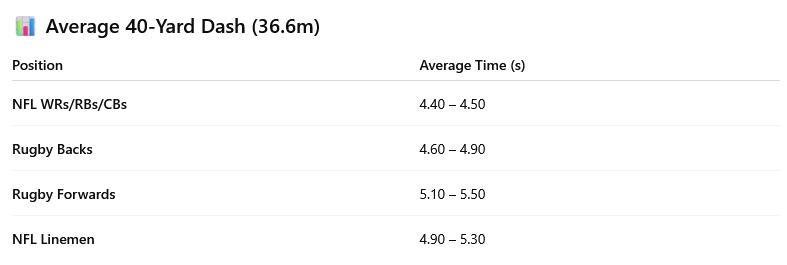NFL vs Rugby: Who’s Stronger, Faster, Fitter?
It’s one of the most debated questions among athletes, fans, and trainers alike — who takes the crown in physical performance: NFL players or rugby union players?
Both sports demand elite-level athleticism — but they’re built for different types of collisions, durations, and movement patterns. So, let’s break it down across three key areas we track at The Rugby Factory: speed, strength, and fitness.
Backed by real-world test data and studies, here’s how these two worlds compare.
🏃♂️ SPEED: Who’s Faster?
🧪 What We Measured:
10m sprint (acceleration)
20m sprint (transition phase)
40m sprint (top-end speed — the NFL Combine standard)
📊 Average 40-Yard Dash (36.6m)
Position Average Time (s) NFL WRs/RBs/CBs 4.40 – 4.50 Rugby Backs 4.60 – 4.90 Rugby Forwards 5.10 – 5.50 NFL Linemen 4.90 – 5.30
🏆 Verdict: NFL wins top-end speed, particularly in positions like wide receivers, running backs, and cornerbacks. Their training is highly specialised for 40-yard explosiveness.
📖 Reference: NFL Combine Data (2023), SRU Sprint Testing, “Sprint Characteristics of Elite Rugby Union Players,” Hamlin et al., 2015
⚡ But… what about 10m and 20m?
Studies show that rugby forwards (particularly loose forwards and hookers) often have better 10m and 20m splits than NFL linemen. Their training blends strength and mobility to generate short-burst acceleration repeatedly — crucial for phase play.
🏋️♂️ STRENGTH: Who Lifts More?
NFL players are famously strong — but rugby players aren’t far behind.
Exercise NFL Average (Elite) Rugby Union Average (Elite) Bench Press 180lb (82.5kg) x 20–30 reps 110–140kg x 5–10 reps Squat 220–280kg 200–250kg Deadlift 250–300kg 220–270kg
📖 Sources: NFL Combine Bench Press Stats, World Rugby Conditioning Guidelines, “Strength & Power Profiles of Elite Rugby Union Players,” Argus et al., 2011
🧠 Important Context:
NFL training is built around max strength and power in short bursts, with longer rest between plays (15–40s).
Rugby training balances strength with repeated-effort power — think 15-20 tackles, scrums, and ruck hits per match.
🏆 Verdict: NFL slightly leads in pure lifting strength, but rugby forwards — especially props and locks — hold their own, with exceptional relative strength and functional power.
🫀 FITNESS: Who’s Fitter?
Rugby wins this one. Hands down.
Test Rugby Average (Backs) Rugby Forwards NFL Players* Bronco Test 4:30 – 5:10 5:00 – 5:40 N/A Beep Test (YoYo) 11.5 – 13.5 10.5 – 12.5 9.0 – 11.0
📖 Data compiled from All Blacks, Springboks, and England Rugby performance staff reports; NFL combine lacks aerobic testing.
NFL players rarely run extended distances in-game. Their average play duration is ~4 seconds, followed by rest. Rugby players are active for 30–40 minutes in an 80-minute match, with constant high-intensity efforts.
🏆 Verdict: Rugby players are significantly fitter, both in aerobic and repeated-effort capacity.
📈 Overall Summary
Category Winner Top Speed (40m) 🏈 NFL Short Sprint (10–20m) 🤝 Tie (position dependent) Max Strength 🏈 NFL Repeated Power 🏉 Rugby Fitness (Endurance) 🏉 Rugby
🚨 The Bottom Line
If you want short-term explosion — NFL dominates.
If you want repeated intensity, full-field coverage, and mental toughness across 80 minutes — rugby takes it.
And if you’re a player or coach trying to get the edge, it’s worth training all three pillars: speed, strength, and fitness. That’s exactly what The Rugby Factory helps you track, test, and improve.
Whether you’re trying to outpace a winger, outmuscle a flanker, or outlast an opponent in the last 10 minutes, we’ve got the tools to help you perform at your peak.
💬 Final Thought
Two sports. Two mindsets.
But the best athletes in both share one thing: They test, measure, and improve constantly.
Join The Rugby Factory and see where you stand.
Your stats. Your story. Your opportunity.



